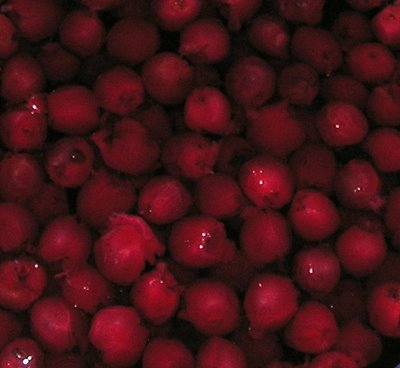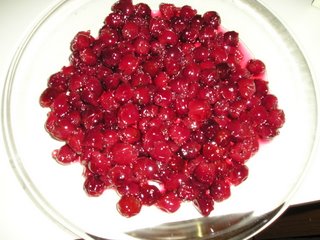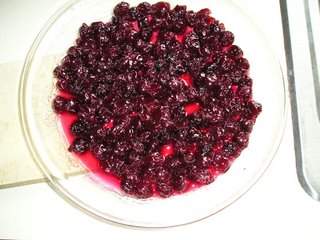God Only Knows How They Make the Green Ones

I'm still in the middle of my cherry fascination, which might go on a bit longer since the orchard that I got them from says that it still has plenty of cherries and that the picking is very good right now, and I have a couple of free hours later today.
I'll likely make some sort of cherry jam before I'm done, but I wanted to try a different approach with some of the fruit. Regular readers of the site will know how much I adore a good fruitcake and how much I suffer when the forces of darkness peddle sugar- and preservative-laden bricks of sawdust under the name of fruitcake leading a gullible nation to believe that fruitcakes can never be more than that.
But they can be. And the first step toward making them be all that they can be (the Army is still famously resistant to enlisting fruitcakes) is to get rid of that muck that the supermarkets sell as glacéed cherries. You know what I'm talking about. Those super sweet, red and green, putatively edible miniature bombs of sugar that are most likely extruded in a factory in a secret CIA prison in Eastern Europe. Evil in a plastic tub.
The glacéed cherries that I made are neither evil nor in a plastic tub. They are sweet, and there's no way around that, but they're also very good, and they taste nothing like you know what.
What they aren't, alas, is fruits confits, the Provencal specialty that you can make yourself if you have tons of time, a hydrometer, and a copy of Mireille Johnston's The Cuisine of the Sun. The process Ms. Johnston describes (I'm going from memory right now because either my copy of the book has been temporarily mislaid or there's a vast right-wing conspiracy to keep me from looking up any of the many recipes that I use from there, and in either case: oh, the humanity!) takes many, many days, very careful measuring with the hydrometer, and glucose. It is something that I intend to make sometime, perhaps later this summer, but it is not something to be undertaken lightly, nor, I think, with tart cherries.
Even though glacéed cherries are much simpler than fruits confits, you still have to commit six days to the process. But none of the work is hard, and it's really only a few minutes on days two through six, and even on day one if you can find a fast way to pit your cherries. The whole thing is also really a kick. It's very satisfying to see the bowl of cherries sitting on your countertop, with the syrup getting heavier and darker every day (the picture above is from day five). You won't want to try this recipe without a new bag of sugar in the house. It's a lot of sugar, though most of it ends up in the syrup, which you can preserve separately.
Glacéed Cherries
1.5 lbs tart cherries
2 cups water
1/2 cup light corn syrup
More sugar than you have
Rinse the cherries well and drain them thoroughly. Remove the pits. Let the cherries and any juice they released during pitting sit in a bowl while you prepare the syrup.
On the first day:
Combine the water, the light corn syrup, and 2/3 cup of sugar in a large saucepan. Bring to a boil. Reduce the heat and add the cherries and their juices. Cook on moderate heat until the temperature reaches 180 degrees. (This should not take long.) Cover the saucepan and let sit for a few minutes, then pour everything into a clean bowl and cover and let sit overnight.
On the second day:
Put a strainer over a saucepan and carefully pour the cherries and syrup into it. Reserve the cherries. Clean the bowl. Add 1.25 cups additional sugar to the syrup and bring it to a boil. Skim it if there's gunk floating in it. Reduce the heat, return the cherries to the syrup, and bring the temperature back up to 180 degrees. Cover the saucepan and let sit for a few minutes, then pour everything into a clean bowl and cover and let sit overnight.
On the third day:
Do what you did on the second day, adding two additional cups of sugar.
On the fourth day:
Do what you did on the second and third days, adding one additional cups of sugar.
 You now have two products to deal with. The cherries need to be dried. If you have a food dehydrator, use it. I don't have one, so I drained the cherries moderately well, then put them and the syrup that was clinging to them into a pie plate. I put that in the warming drawer of our oven on the lowest setting overnight. The next morning, I drained off the remaining (very thick) syrup, cleaned the pie plate, put the cherries back in the pie plate and returned it to the warming drawer.
You now have two products to deal with. The cherries need to be dried. If you have a food dehydrator, use it. I don't have one, so I drained the cherries moderately well, then put them and the syrup that was clinging to them into a pie plate. I put that in the warming drawer of our oven on the lowest setting overnight. The next morning, I drained off the remaining (very thick) syrup, cleaned the pie plate, put the cherries back in the pie plate and returned it to the warming drawer. The syrup can be brought back to a boil and put into jars and processed. You should have around about five cups of it, so you can get two pints of syrup put by with some left over for immediate use. I washed my pint jars, lids, and rings in hot soapy water, put them on a baking sheet and put them in a 225 degree oven while I was dealing with the syrup and cherries, so they were in there about fifteen minutes. Then I poured the syrup directly from the saucepan into the jars, leaving not quite half an inch of space at the top, screwed the lids on, and processed in a boiling water bath for ten minutes. I have no idea how much of that was necessary, but it seems prudent to be safe when you're putting foods by.
The syrup can be brought back to a boil and put into jars and processed. You should have around about five cups of it, so you can get two pints of syrup put by with some left over for immediate use. I washed my pint jars, lids, and rings in hot soapy water, put them on a baking sheet and put them in a 225 degree oven while I was dealing with the syrup and cherries, so they were in there about fifteen minutes. Then I poured the syrup directly from the saucepan into the jars, leaving not quite half an inch of space at the top, screwed the lids on, and processed in a boiling water bath for ten minutes. I have no idea how much of that was necessary, but it seems prudent to be safe when you're putting foods by.You can't tell from the picture, but the syrup is essentially the color of liquid garnets. It truly is beautiful. It's also little more than sugar, and it really doesn't have all that strong of a cherry taste. It will, however, make a terrific pink lemonade. And you can probably use it anywhere else you'd use very heavy syrup and either want or don't mind a strong red color.
 The first problem with this recipe is that it's a large investment of time (though not effort) for a relatively small amount of product, unless you count the syrup, which you really shouldn't, unless pink lemonade is the most important thing in your life (and, hey, you could do a lot worse). The syrup seemed more than adequate for the amount of fruit, so I think that when I make this again (which I will), I'll double the syrup and quadruple the fruit so that I end up with a much bigger haul of glacéed cherries and, hopefully, a syrup with a stronger cherry flavor.
The first problem with this recipe is that it's a large investment of time (though not effort) for a relatively small amount of product, unless you count the syrup, which you really shouldn't, unless pink lemonade is the most important thing in your life (and, hey, you could do a lot worse). The syrup seemed more than adequate for the amount of fruit, so I think that when I make this again (which I will), I'll double the syrup and quadruple the fruit so that I end up with a much bigger haul of glacéed cherries and, hopefully, a syrup with a stronger cherry flavor.The second problem with this recipe is that it's really a lot of fun, and when you've been through it, you're likely to be a little annoyed at your significant other for not having had the foresight to plant a few apricot trees so that you could do the same process with a bushel or two of apricots. V. thinks that it's entirely unreasonable of me to be put out with him about the lack of apricot trees in the back yard, but, really, if you're a gay man, how hard is it to foresee that you might end up sharing your home with someone who demands fresh apricots? Not that hard.
I didn't follow the process precisely, and on a couple of occasions, most notably on day one, I let the cherries get significantly too hot after I added them to the syrup, and they cracked as a result. I'm not sure that any amount of care keeps you from ending up with something that looks like craisins, but I'll certainly be more careful the next time (or when that bushel of fresh apricots arrives).
I'm also encouraged to try the full out fruits confits. I reckon that it's time to order a hydrometer.

2 Comments:
These are soooo cool. When the fresh cherries are over, you might like to try my recipe for homemade maraschino cherries, perfected after numerous less successful experiments, to wit:
Take a bunch of organic dried cherries, and put them in a ball jar. Pour Luxardo Maraschino liquor over to cover. Put lid on jar. Let it sit on a dark shelf for a couple of weeks, then refrigerate. Manhattans and icecream sundaes never had it so good.
Green glace cherries harbour demonic nonfoods. Consume at your peril.
First, I am amazed at the amount of complex kitchenry you engage in. You're just, well, cool.
Secondly, I very nearly drowned myself when I read your ingredients list: "More sugar than you have," made me snort and laugh and don't you know I'd just taken a swig of coffee...
Lastly: I've lived with apricot trees in the backyard and you absolutely must take my word for it: it's not so romantic. They all become ripe at the very same instant, you see, and you've got about four hours to pick the ones you'll be using. Then the remaining fruit -- all two hundred bushels of it -- drops off the trees in the very same instant and begins to rot immediately. Then suddenly you've got more bugs than you've ever seen in your life, and birds too drunk to eat them, and someone will send you out with garbage bags to pick up the rotting fruit so the lawn isn't ruined. It's awful. Better to buy your apricots, I swear.
Post a Comment
<< Home